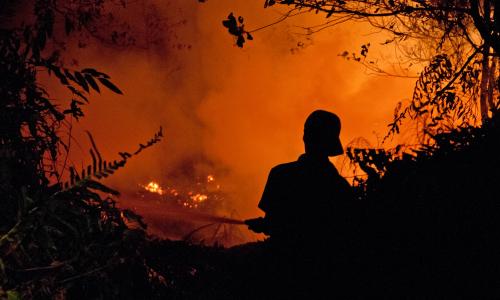
Beyond Swidden Agriculture: Rethinking Approach to Fires
This article was published on The Jakarta Post, November 12, 2019.
The use of fire in swidden agriculture is not as simple as just burning down the forest. It presents an interconnected relationship between ecological knowledge and socialcultural values. However, swiddening communities are often accused as being one of the contributors to catastrophic fires in Indonesia. In addition, they often become victims of reactive fire policies (e.g. the prohibition of using fire).
Swidden agriculture is part of the livelihood (either fully or partly) for 14 to 34 million rural people in Southeast Asia. Fire swiddening has long been a cornerstone of agricultural practices in Indonesia. In general, swiddening is a practice of subsistence agriculture (e.g. to plant rice) to feed local communities. It involves converting secondary forest areas into fields for planting crops using slash and burn techniques to clear the area of trees or other vegetation. This practice is very common in Kalimantan, including by indigenous Dayak communities. For them, ecological aspects and sociocultural values are fundamental factors in practicing swidden agriculture.
Ecological aspects in practicing swidden agriculture among Dayak communities represents their perception of the conditions of the forests and soils around them. They hold ecological knowledge of rotating the conversion of secondary forest into rice fields based on time periods (e.g. yearly or every five years), so that vegetation of plants and trees in abandoned fields can grow back. Depending on the interval between rotations, swiddening provides time for ecosystems to naturally restore themselves, for instance by using chemical fertilizer.
When using fire to convert forests into fields, the burned remnants are used as natural fertilizer to improve yields. Burning is also used to reduce weeds and pests in the period of rice growth, hence reducing the need for chemical fertilizers, pesticides and herbicides and thereby bringing down production costs. The knowledge of using fire in swiddening has been passed down through generations, along with sociocultural values to conduct the practice in an environmentally and socially sustainable way.
Sociocultural values can be seen in the way the communities practice burning to clear land. Community members who own adjacent fields usually form groups to create firebreaks by cleaning the flammable vegetation on the sides of the fields. Such firebreaks are built to reduce the risk of fire spreading to other lands. This practice is derived from the customary law that stipulates sanctions if fire spreads to other lands, forests or rubber plantations. In short, the values, including the indigenous rules, sanctions and rituals, indicate that these communities have social and cultural awareness in using and managing fires.
Reflecting on the meaning of the use and management of fire in Dayak’s perceptions, we need to rethink the solutions to overcome fires, especially pertaining to swidden agriculture. Reactive solutions have proven to be less effective in dealing with recurrent annual fires.
Economy-based solutions that are often offered — for example, providing excavators for communities to clear land without burning, hiring locals as firefighters to prevent swiddening or creating lowland permanent rainfed ecosystems — are not solutions that have holistically assessed the community’s perception of swidden agriculture. Economic-based solutions might work well for communities whose perceptions are dominated by profit orientation.
However, they might not be a cultural fit for communities whose perceptions are dominated by sociocultural values. For such communities, legally recognizing their local knowledge and customary law on fire management that is environmentally and socioculturally sustainable might be a solution. This recognition must also be followed up by regulations that detail, for example, the maximum size of land and the type of ecosystem that may be burned for swidden agricultural practices.
Several regulations (including the 1999 Forestry Law, the 2009 Environmental Protection and Management Law, the Environment and Forestry Ministry Regulation No. 10/2010 and the Government Regulation No. 71/2014) stipulate the maximum size of areas to burn, the required permit and an acknowledgement of local knowledge in using fire to clear land. To complement these regulations, an in-depth assessment of environmental impacts and local perceptions of fire-use is essential, because communities may have different perspectives and environmental conditions.
Therefore, we urgently need a specified fire policy that is designed in accordance with the perception of each actor group, because changing behavior that has lasted for hundreds of years may be very challenging.
Researchers and the government should work together to formulate a better fire solution through a comprehensive understanding of the complex interwoven social, cultural and ecological values that form the fundamental relationship between humans and their environment.
In addition, providing intensive assistance to local communities in implementing culturally acceptable programs is also important to generate favorable outcomes in dealing with fires.